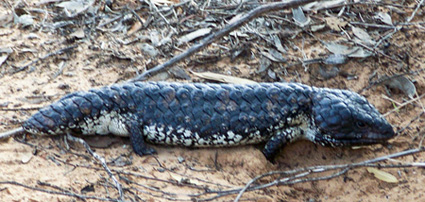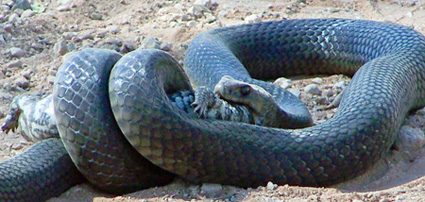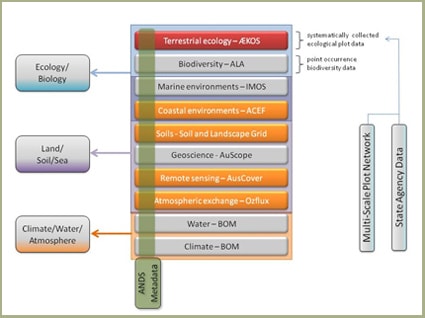Charles Darwin and Alfred Wallace are the most famous Western observers of nature we know. Researchers like them have been collecting data on plants and animals for centuries to detect patterns in the evolution. Data of this type held in museums and herbariums are typically called biodiversity data: they more often than not are used to describe species occurrences. Ecology, in contrast, is the more complex study of the relationships of living things with each other and with their environments – and it is these relationships that are significant in conservation and management.
Let’s consider an example, Australia’s iconic sleepy lizard, which also goes by several other common names: shingleback, stumpy-tailed skink, boggi, and bobtail lizard. Its scientific name was once Trachydosaurus rugosa and is now Tiliqua rugosa; and, based on genetic data, it has been classified as having four related (or phylogenetic) subspecies.
Data collected on this lizard help us paint a vivid picture of its life. We know that it’s herbivorous and occurs in many habitats in southern Australia. And data on ectoparasites (which live on or in the skin) show us that in some areas the sleepy lizard can become infected with ticks which, if present in large enough numbers, can reduce its body weight. Population data collected over 30 years tell us that it lives for between 20 and 50 years, that pairs tend to mate for life, and that the parents care for their offspring for a year. Data also tell us that juveniles are dinner for foxes, cats and large venomous snakes. Genetic data tell us that revegetated habitats scattered throughout cereal cropping lands are important for breeding and the dispersal of juveniles, although physiological data suggest that many become chronically ill when exposed to agricultural chemicals.
From this thumbnail sketch, it quickly becomes apparent that understanding the ecology of just one species involves many different types of data – and that data are collected using different methods at different localities and times, and by different people to answer seemingly unrelated questions. Add the complexity of data on other species and relationships, and things quickly threaten to become overwhelming. It is in this environment that Eco-informatics operates. In fact, the data are so complex and interwoven that contemporary semantic approaches are needed to make the most of it. Eco-informatics is at the cutting edge of worldwide innovation in this area, putting ecological data at researchers’ fingertips through its online data portal, the Australian Ecological Knowledge and Observation System (ÆKOS).


Left, a sleepy lizard (Tiliqua rugosa) minding its own business (photo by Anita Smyth). Right, it pays not to be too sleepy: a juvenile being swallowed by a
common brown snake (Pseudonaja textilis) (photo by Mina Ansari).
The Ecological Information Manager at Eco-informatics, Dr David Turner, said the complexity of ecology resulted in individual datasets having a relatively limited scope due to specialisation. In contrast, many of the emerging problems for growing an environmentally sustainable Australia required integration of diverse data so they could be adequately examined or put together in new ways to provide insights not possible before.
‘Whilst this could be partially addressed through large scale collection of new data, this is often impractical as data are generally expensive to collect, and individual observations are often irreplaceable. Finding new ways to re-use existing information can provide an effective alternative and also helps maximise the value of the initial collection effort,’ David says.
The re-use of rich ecological data can advance our understanding of nature, the environment and human interactions by stimulating new science and improving existing knowledge. It can be used for widely differing purposes. For instance, consider the impact climate change may have on plants, animals and the bush in the next 60 years: in a recent study researchers used volumes of ecological data to understand the extraordinary implications of unprecedented climate change for science, policy and management. Alternatively, consider the challenge of managing for a balance between preventing wildfires and permitting controlled burns that are essential for the conservation of some species. The modelling of ecological data on plant species population changes with fire behaviour can be used to predict when bushfires threaten human life and property.

Wildfire in the MacDonnell Ranges, west of Alice Springs (Photo by Michael Barrett)
‘For data re-purposing to be viable, information needs to be stored and presented in a manner that facilitates re-examination and manipulation,’ David says. ‘For example, up until the advent of ÆKOS it’s been quite difficult to access and understand complex ecological data because there’s been no database tooling available to store and deliver description and context associated with the data – knowledge that’s essential for re-purposing. This is because much of the important contextual information is implicit to the original researcher and hasn’t been transcribed into existing databases along with the observational data. Instead it’s been left in field notebooks kept in a filing cabinet, or on old, disused media. This is generally because of digitising costs and also because of the issue with traditional database tooling.’
The Director of Eco-informatics, Mr Craig Walker, said ÆKOS’s sophisticated online portal for rich ecological plant data would be released as a trial (or beta) version in December. In later production releases, animal data would be added.
The portal enables users to browse, search, view and retrieve many different types of data and knowledge for systematically collected observations at the sampling unit level (i.e. plot, quadrat, transect, trapping array, tissue sample). Datasets can be accessed as metadata only, or metadata with data in an attached file such as an Excel spreadsheet, or as fully integrated and federated data with contextual information describing the data in detail so that researchers can assess its fitness for re-use.
‘Our portal enables researchers to select records from many different datasets, combine them, and download using a shopping cart. Research infrastructure of this kind is unique and innovative in the environmental information landscape – ÆKOS is one of the only players in this niche at present,’ Craig says.
‘We are expending significant time and effort in integrating data and adding knowledge, and this is of benefit to researchers because it puts a store of incredibly rich data at their disposal in an appropriate form. This helps them to discover and assess suitability of the data much more quickly, and then provides easy access for incorporation into their research.’
Data stored in ÆKOS are free and openly accessible under Creative Commons Attribution 3.0 Australia or Creative Commons Share Alike 3.0 Australia licences, or the TERN Attribution Licence. Restricted data (less than 1% of datasets) are not currently published and remain with data custodians.
For more information, contact Eco-informatics’ Ecological Information Manager Dr David Turner on (08) 8313 1191.

The niche ÆKOS occupies in the national environmental information
landscape in Australia. (The others are: ALA, Atlas of Living Australia; IMOS,
Integrated Marine Observing System; ACEF, TERN’s Australian Coastal
Ecosystems Facility; TERN’s Soils and Landscape Grid of Australia;
AuScope; TERN’s AusCover; TERN’s OzFlux; BOM, Bureau of Meteorology;
TERN’s Multi-Scale Plot Network; and ANDS, Australian National Data Service.)
Published in the TERN e-Newsletter, October 2012






